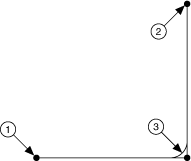Blending
Blending, also called velocity blending, superimposes the velocity profiles of two moves to maintain continuous motion. Blending is useful when continuous motion between concatenated move segments is important. Examples of some applications that can use blending are scanning, welding, inspection, and fluid dispensing.
Blending must occur on velocity profiles of two move segments, so the end positions of each move segment may or may not be reached. For example, if you are blending two straight-line moves that form a 90º angle, the blended move must round the corner to make the move continuous. In this case, the move never reaches the exact position where the two straight lines meet, but instead follows the rounded corner, as shown in the following figure.
|
|
| 1 Starting Position | 3 Corner Rounded by Blending |
| 2 End Point | |
Motion controllers can perform blending between two straight-line moves, between two arc moves, or between straight-line and arc moves. Blending does not work for reference and contoured moves.
Because blending occurs on velocity profiles, the effect of reaching the end positions of the move segments and the maximum velocity depends on the velocity, acceleration, deceleration, and jerk loaded for the two move segments.
Because two move segments are always used while blending, it is very important that you wait for the blend to complete before loading the next move segment you want to blend.
Blending Algorithm
The following figure shows a generic blending algorithm applicable to both C/C++ and LabVIEW code.

